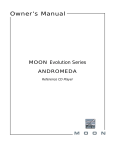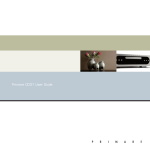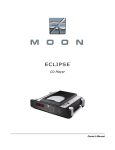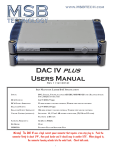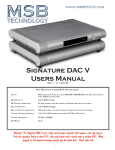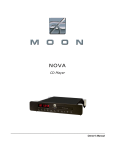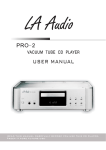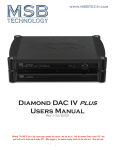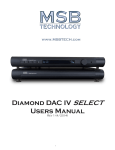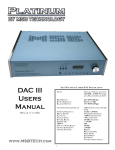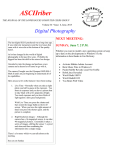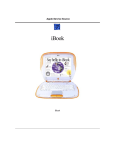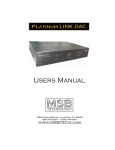Download MSB Technology Gold Link Dac III Specifications
Transcript
Power DAC Users Manual Sign Magnitude Ladder DAC Specifications Inputs: RCA Outputs: Output Impedance: Balanced Output: Coaxial, Toslink, balanced AES/EBU, MSB Network 3.6 V RMS (10 Vpp) 50 ohms at 0 dB 7.5 V RMS (20 Vpp) Sampling Frequency: 32 kHz to 384 kHz Digital Filter: 16 times Oversampling Slew rate: >2500 V/microsecond Settling Time: <90 nanoseconds Dynamic Range: 136 dBA measured Noise Floor: < -145 dB THD+N: .002 Signal to Noise Ratio: 140 dB Channel Separation: >130 dB Master Clock: +/- 2.5 ppm Low Jitter Control Features:Filter Option Battery Mode Rev 3 (9/06) Power DAC Users Manual Unique Product - a Battery Powered DAC? This product combines a unique combination of a very high performance DAC and the ultimate power supply - batteries. Batteries give an amazingly high instantaneous current with no noise. Nothing else can compare. A Simple Approach The Power DAC takes a different approach from other MSB products. We took the best of our own MSB DAC technology and put it with the best power supply technology in a no-frills package with no fancy features or upgrade options. The result in a level of integration that boosts performance and keeps costs low. The Power DAC has the performance of a Platinum DAC at the price of a GOLD. Setup and Quick Start This is easy. Plug it in and go. Power - The Power DAC will operate on batteries up to 10 hours but should be left plugged into the charger. A switch on the front allows it to operate on batteries only, and will automatically switch back to charging when the batteries are depleted. Inputs - The Power DAC comes standard with one MSB Network (CAT5), AES/EBU balanced, coaxial and optical digital audio inputs. Connect any digital input to any active digital audio source and it will automatically be selected. Outputs Connect the balanced or single-ended analog outputs to any amplifier and audio should be present if your digital input is active. Burn-In The concept of burn-in is little understood. Does it take your ears some time to get used to the incredibly detailed and life like sound of an MSB product or is something actually changing. The feedback we receive leads us to recommend at least 100 hours of burn-in on this DAC. Customers generally recommend one month. Battery Life and Replacement The batteries in the Power DAC should last 4 to 6 years depending on use. For maximum life the batteries should always be kept fully charged. As the batteries get older the battery play time will be reduced. It starts out about 10 hours of play without charging. When the play time is reduced to 6 hours, the batteries should be replaced. You may purchase replacement batteries on-line or from many suppliers. They are sealed lead acid batteries and used batteries should be recycled. To replace the batteries, purchase: 1) Powersonic PS-670 or equivalent 4) Powersonic PS-612 or equivalent These should cost about $50. “Better” batteries will not likely produce better sound but they may last a little longer. Battery charge time varies but approximately equals the play time. So after 5 hours of playing, it will take 5 hours to recharge. The battery charger is very advanced and designed to always be connected. It will NOT ever overcharge but will optimize battery life. Charger The charger is configured for either 100 to 120 VAC input or is configured to 200 to 240 VAC input. Both configurations can be used at 50 or 60 Hz. It is supplied with a DIN cable and AC cable. Longer DIN cables can be purchased for remote charger placement. For best performance, do not place the charger on top of the unit. Storage To store the Power DAC, fully charge the batteries. Store in a cool place for up to 4 months. If you need to store the product for more than 4 months without recharging, remove the batteries and recycle. When you take the product out of storage, purchase new batteries. Unique Technology - the past and the future Over 10 years ago early DACs were all 16 bit ladder DACs, with a precision laser-trimmed resistor creating the appropriate analog level for each of the bits. The DACs worked well and sounded good. They were quite expensive as very accurate resistors were required. Then along came the “single bit” DACs. Rather than using a resistor to create an analog level, pulse width modulation was used. Basically each bit was created by turning a switch on and off for the appropriate length of time. The resulting square wave pattern was filtered to create a smooth output. The expensive resistors were gone, and so was the good performance. Next came the Delta Sigma DAC. It used the same pulse width modulation but rather than creating a single large pulse for each data point, the data point was created with many small pulses. This allows the pulses to be smoothed with a less radical filter, and improves the sound. As you can see, upsampling the input signal to a higher frequency reduces the filtering requirements and thus improves the sound. This is the current state-of-the-art as exemplified in the LINK DAC III with the upsampling option. The Power DAC draws from the older, superior ladder technology, but with incredible improvements. The Power DAC has two 24 bit MSB DAC’s built-in. Each DAC contains one R2R ladder DAC with a 23 bit negative sign and one R2R ladder DAC with a 23 bit positive sign. Together this makes a true 24 bit DAC. This design allows the quieter moments in your music to be true to the music, without the linearity errors near zero that plague normal ladder and delta-sigma DAC designs. With a dual 24 bits of combined resolution, a 24 bit source gives a true 24 bit resolution without the losses and errors that make your normal 16 or 24 bit DAC perform far less than their actual resolution (normal 16 bit DACs only muster a meager 12 bits of resolution). The Power DAC is carefully designed so as to require no DC correction in the output stage. This allows direct DC coupling on the output stage for pure, uncolored sound -- with no output filtering to muck up your high end or smear your bass attack. And for those who require a balanced analog output, the separate positive and negative DACs directly drive the balanced outputs, with no analog output stage at all! Another major difference in the Power DAC is the type of output. Essentially all ladder DACs produce a current output. This is converted to a voltage output with a current to voltage converter. This problematic circuit colors the sound and introduces non-linearity. The Power DAC is a true voltage DAC with a voltage output right from the source. All amplifiers have slew rates greater than 2500 Volts/microsecond. The output impedance of the Power DAC is 50 ohms. Special Features The Power DAC has many special features. The following sections discuss these features and how they work. Upsampling and filtering As MSB technology has developed, so has our DAC architecture. Our advanced digital filter now replaces the asynchronous upsampling of earlier models. The 16X Digital filter goes way beyond our older 4X upsampling. To play a 24/192 disc the Power DAC only needs to be plugged into a DVD-A player with an MSB XPORT output. The new upsampling feature dynamically buffers and re-clocks all the data and clock signals to provide a virtually jitter-free source directly to the DACs. The selectable digital filter response permits the user to choose the filter design they prefer. It allows for the selection of a standard brick-wall filter or a slow roll-off filter, both at half the sampling frequency. Each provide a distinct, glorious listening experience. You may favor one or the other, or enjoy changing the filter response to suit the music you listen to. Music with less high frequencies may benefit from the slow roll-off filter. To play a 24/192 disc the source player needs to have an MSB Network or XPORT output. If your DVD-A player does not have the MSB Network output, it can be added. A 192k input will override the upsampling settings. Custom MSB Digital Filter The Power DAC has a custom DSP based Digital filter and clock module. We have created our own Custom Digital Filter for the MSB DACs. Previous versions of the our DACs used the Burr-Brown DF1704, which at the time was the best Digital Filter on the market. Our Digital Filter is built to our specifications and standards, and is designed to get the most out of Upsampling Effect the Power DAC. The performance of this Digital Filter is amazing. Immediately you’ll notice the lack of fuzziness around voices and instruments of all frequencies. This filter also dramatically increases the resolution and dynamics of the machine. This filter is also completely customizable; By playing a special .wav file on a CD new filter coefficients, either temporary or permanent, can be loaded into our DSP. The Digital Filter is a 16x oversampling, single stage filter with 32 bit input resolution, 80 bit computation, and 36 bit coefficients. About the Clock / Jitter Control Jitter control devices (and inputs on most DACs) normally reclock the input signal in attempt to lessen the jitter of that incoming signal. The Power DAC does no such re-clocking. We actually pay no attention to the clock on the input signal. All internal clocks are generated by an extremely accurate +/- 2.5 ppm temperature compensated clock. Since the input clock is no longer related to the clock of the Power DAC, an intelligent ½ second buffer is used to maintain data synchronization. The MSB 16x Digital Filter is an ultra high-resolution digital front end. The combination of a highspeed on-board computer and carefully optimized software and hardware result in the best possible Sign Wave (0 db, 19.95 kHz test music quality. During the development of this peerless digital audio system MSB has accumulated a tone Scope settings 2 V/div, 10 wide body of unique knowledge allowing us to design the ultimate digital filter. usec/div) More About the Digital Filter One of our primary goals at MSB is to provide the music lover with the most accurate musical experience possible. During years of careful design and improvement of our custom discrete DACs, which form the heart of your Power DAC, we realized that the Power DACs sound quality was no longer limited by them. We soon narrowed the problem to the Digital Filter which was feeding our DACs. While the excellent Burr-Brown (Now owned by Texas Instruments) DF1704 Digital Filter had served us well in the past, it had became the bottleneck once we started using our new Second Generation DAC modules. After a thorough search of all the available off the shelf and custom DSP based Digital Filters we realized that little improvement could be had from any of them. With no other option in sight we decided to build our own solution. Converting the ones and zeros of Digital Audio into music is an enormously delicate and critical process. Each individual sample that makes up the audio stream must be converted into the high resolution, continuous analog voltage that can be transformed into the sound that you hear. Any misstep can corrupt the final result ending with audio that does not sound anything like the original recording. Errors in translation can make a harsh, veiled, muddy, and/or tonally colored result. Minimizing each potential problem allows the original recording to shine through. Audio reproduction starts when the DAC receives the binary coded information from the source. The first step requires recovering the audio samples, which represent the final output voltages, and the timing, which tells the DAC when to output those voltages. Next the sample rate is raised and the data is digitally filtered. While it is possible to feed the DAC with the original audio samples thereby avoiding the use of a digital filter skipping this step has many unintended consequences. After being digitally filtered the digital stream is feed to the DAC. The DAC receives the digital audio samples and converts them into a continuous analog voltage. The best DACs, such as our Second Generation DAC Modules or Signature DAC Modules, instantly convert the data into a precise continuous voltage waveform with timing determined by the DACs conversion clock. The digital filter is necessary because mirrored image frequencies created during the conversion process must be removed. If the DAC did not have a digital filter, an analog filter with an aggressive response must remove these image frequencies. These brick wall analog filters seriously damage the signal by corrupting the original phase of the sound and cannot fully remove the high frequency images. This results in harsh or rolled off high frequencies and poor soundstage focus. Traditional digital filter designs consist of cascaded FIR (Finite Impulse Response) filters, each of which raise the sample rate by two. The intermediate data between the filters is usually stored at less than 40 bit resolution. Since the next filter works with previously computed data the resolution decreases with each filter pass. This limits higher quality digital filters to a low oversampling rate (usually 8x) before the output starts to deteriorate. The loss in resolution is typically not apparent when using the best conventional digital filters with standard DAC chips, but in combination with our high resolution 24 bit Second Generation, or Signature DACs the problem is very apparent. The sound becomes muddy, veiled and un-involving when using any off the shelf digital filter. To counter this problem the MSB 16x Digital Filter does it’s filtering in one filter stage that raises the sampling rate by 16. FIR filters operate by multiplying each sample in the data by a set of filter coefficients and then summing the result. Most digital filters round the result of each addition before the adding next sample. This repeated roundoff results in a similar problem to the cascaded 2x filter approach, muddy sound. MSBs digital filter uses bit perfect accumulation in an 80 bit accumulator completely eliminating these debilitating roundoff errors. Only as the last step do we carefully convert the audio to the 24 bits our DACs require. The high sampling rate of the output allows us to include advanced ultrasonic dither and noise shaping techniques in this step to achieve greater than 24 bit effective resolution. Through extensive listening tests we have found that the choice of filter coefficients has a great impact on the tone of the music. We have found that steep, phase perfect “Brick Wall” filters tend to sound the most neutral but are also the most difficult to implement without problems. Improvements we have made in our digital filter, with its single stage design and 80 bit computation, allow us to use very steep filters with no compromises. Custom Filter Options We recognize that different people often have very different taste in their music. For those who do not like the standard choice of filter, or require a different filter response, we have provided a very easy method for customizing your MSB 16x Digital Filter. By playing a standard CD containing a custom filter algorithm you can temporarily change the filter inside your 16x Digital Filter. This CD filter loading allows you to load almost any FIR filter quickly and easily. You may also upgrade your MSB 16x Digital Filter with the latest custom software just by playing a special Firmware Upgrade CD. Clock Jitter The timing of the DACs conversion clock also has a large impact on sound quality. Any periodic frequency change or “jitter” causes a loss of focus in the reproduced audio. The high power and large memory space of the SHARC DSP we use allows us to offer a unique Ultra Clock to your MSB 16x Digital Filter. The Ultra Clock adds two ultra precision, ultra low jitter TCXO oscillators and custom clock handling circuitry to your board. This custom circuitry allows us to do much more than simply reclock the data, as other jitter reduction boxes do, but completely replace the incoming clock! Most jitter reduction schemes rely on Phase Locked Loops or Asynchronous Sample Rate Converters. The Phase Locked Loop is able to reduce jitter to a significant degree but not eliminate it because the output clock must be related to the input clock. The Asynchronous Sample Rate Converter, which completely replaces the data and clock, seems ideal until you realize that the complex computation involved harms the data by permanently imbedding a portion of the clock jitter into the data. Sample Rate conversion is also detrimental to the sound due to the complex and sub optimal digital filters involved, which must change their filter response to track minute changes in the input to output clock ratio. The Ultra Clock sidesteps both of these problems by storing the incoming data in an extremely large buffer (1/2 second of audio.) The on-board clock then reads out the data without jitter. The on-board clocks are totally independent from the input clock so that no jitter is transferred to the output. True absolute digital silences such as a track skips are selectively shortened or lengthened by the DSP to keep the buffer synchronized. This process is carried out seamlessly by the DSP to assure that all compatible sample rates have their clocks properly replaced. Compatible sample rates are 44.1 kHz, 96 kHz, 176.4 kHz, 192 kHz, and 384 kHz. Other sample rates automatically use the recovered clock from the transport without user intervention. The 48 kHz sample rate does not support clock replacement due to the large latency incurred by the buffer, which would cause audio from a DVD movie to be unsynchronized. Custom Software and Temporary Filters A custom digital filter will allow you to tailor the sound of your Power DAC. Any form of custom FIR filter may be loaded into the MSB 16x Digital Filter. You may select a custom filter from our library, you may have MSB design a filter to your specifications or you may send MSB a list of Fir Filter coefficients that we can format into a CD loadable file for you. You cannot permanently damage your 16x Digital Filter Board by loading a Temporary Custom Filter, it is only active until you toggle the Filter Option Button, Power down the Power DAC or play an audio track containing the Special Cancellation Code. Contact MSB Technology for details on custom filters. Step One, Verify Your Equipment Compatibility - To successfully load your custom filter you must have your Power DAC connected to a transport that will not change the Data. Almost all CD players are acceptable, however there are some important exceptions. Upsampling CD transports will not work; this includes the drive internal to the MSB Reference CD Player and MSB Reference CD Station II. You will have to connect your Power DAC to another source to load the custom filter file. The Upsampling drives are fine for playing audio after the upload however. DVD players should work fine when they are configured in a mode that does not affect the Data such as CD pass-through mode. Step Two, Burn the CD - When burning a CD containing the custom filter you must burn the WAVE audio file directly to a CD without first converting it to another audio format such as MP3. Converting the WAVE file to another format will destroy the careful formatting which allows DSP to load filters directly from a CD. You may however burn other audio to the CD as separate tracks. This allows you to create a CD with a custom sound that differs from the rest of your collection. A suggestion is to place a track containing the Custom Filter on the CD as track 1 and place the Special Filter Cancellation Code as the last track. This will allow a CD to play through with a custom filter leaving your Power DAC in the normal filter mode at the end of the CD. Step Three, Play the CD - To ensure a proper load of the filter you must remember to disable any digital processing before the 16x Digital Filter. This includes turning off processing in DVD players, Upsampling in CD Players and Upsampling in the Power DAC itself. If the Filter Load Fails because the equipment is not compatible or the track is not played trough the MSB 16x Digital Filter the track containing the Custom Filter will play a short very quiet noise burst followed by a Filter Update Failed message. A successful load will just be a short, five-second silence. Step Four, Cancel the Filter - A custom loaded filter in a MSB 16x Digital Filter will remain the dominant filter of the DSP until some action is taken by the user to cancel it. Toggling the Filter Option Button, powering down the unit, playing a CD track with the Special Filter Cancellation Code or loading a new Temporary Custom Filter will immediately cancel the filter. Loading New Firmware Loading custom 16x Digital Filter Firmware will permanently change the operation of your DSP. MSB Technology can configure custom software for your DSP to meet virtually any requirement. Playing a CD track containing the new firmware will erase the current software in your 16x Digital Filter and replace it with the contents of the update file. This is just as safe as loading a Custom Digital Filter if one precaution is faithfully observed. The firmware update process takes about 20-30 seconds and you MUST NOT INTERRUPT THE POWER TO THE Power DAC while the new firmware is loading. You must wait for the message after the Firmware Update before interrupting your Power DACs power. If the power to the Power DAC is interrupted during a firmware update you will have to return your Power DAC to MSB for reprogramming. MSB will charge you a small fee for this service. If you have accidentally loaded firmware that you do not wish to have on your Power DAC do not try to cancel it while it is loading, simply wait for the update to complete and then load the firmware you do wish to have in your Power DAC. Step One, Verify Your Equipment Compatibility - To successfully load your new Firmware you must have your Power DAC connected to a transport that will not change the DATA. Almost all CD Players are acceptable however there are some exceptions. Upsampling CD transports will not work; this includes the drive internal to the older MSB Reference CD Player and Reference CD Station 2. To load a firmware file to these machines you will have to connect your Power DAC to another source to load the firmware. The Upsampling drives are fine for playing audio after the upload however. DVD players should work fine when they are configured in a mode that does not affect the Data such as CD pass-through mode when connected to their s/pdif digital output. Step Two, Burn the CD - When burning a CD containing the new firmware you must burn the WAVE audio file directly to a CD without first converting it to another audio format such as MP3. Converting the WAVE file to another format will destroy the careful formatting which allows DSP to load its new Firmware directly from a CD. You cannot however corrupt the Firmware in a way that will allow it to load incorrect software. The firmware update file is protected by powerful error detection and encryption that will not allow a damaged file to be loaded into the DSP. A corrupted or damaged firmware CD will simply be rejected by the DSP and fail to load the new software. Step Three, Play the CD - To ensure a proper load of the firmware you must remember to disable any digital processing before the 16x Digital Filter. This includes turning off any processing in DVD players or upsampling in CD players. If the Filter Load Fails (the equipment is not compatible or the track is not played trough the MSB 16x Digital Filter) the track containing the new firmware will play a short very quiet noise burst followed by a Firmware Update Failed message. A successful load will just be a 20-30 second silence followed by a New Firmware Conformation message. The new firmware is running at this point, you do not have to restart your Power DAC to enable the new features. Step Four, Enjoy Your New Features - Custom Firmware permanently changes the software running on your DSP. This change occurs immediately following a firmware update. You do not need to reset or power off your Power DAC. Powering the unit off after a firmware update will load the new software on power-up, the old software was completely erased. If you are not happy with your new firmware simply load your old firmware using the instructions above. Clock Interface (advanced users) On the back of the unit is a special 5 pin XLR type connector. It is a clock interface that allows multiple Power DAC products to be synchronized, allows the Power DAC Clock to be output and allows an external clock to be input to the Power DAC. The interface is a LVDS format clock interface with a signal level of 250 mV pp input or output requirement. Pin Identification - The pins shown in the figure above are identified as follows: 1. Ground 2. Clock Select (OPEN = Master Clock Output, LOW = Master Clock Input) 3. M Clock + (Positive side of balanced Master Clock) 4. M Clock - (Negative side of balanced Master Clock) 5. DSP Ready for Networking (OPEN = OK to Run, LOW = Stop, not ready) Clock Frequencies - By toggling the Clock Select line clocks can either be input or output. The output frequencies are as follows: · 44.1, 88.2 or 176.4 kHz sampling frequency source outputs a clock frequency of 22.5792 MHz · 48, 96 or 192 kHz sampling frequency source outputs a clock frequency of 24.576 MHz The input frequency requirements are as follows: · 44.1 kHz source will accept a 11.2896 or 22.5792 MHz input · 48 kHz source will accept a 12.2880 or 24.576 MHz input · 88.2 or 176.4 kHz source will accept a 22.5792 MHz input · 96 or 192 kHz source will accept a 24.576 MHz input · 384 kHz source will accept a 24.576 MHz input · 352.8 kHz source will accept a 22.5792 MHz input Front Panel Controls Play Mode and Battery Display – The PLAY MODE button is used to switch the Power DAC into the highest quality playback mode. When the battery charger is plugged in, pressing the button disconnects the battery charger internally. The blue LED above the button turns on. When pressed again the LED goes out and the charger is connected. A charge LED lights to indicate current charging status. When the battery charger is disconnected, the button turns the DAC on and off. When on, the LED is lit and the DAC will play from battery power. When toggled off, no LEDs are lit and the DAC is off. FULL CHARGE LED – This LED is lit when the charger is plugged in and the batteries are fully charged. This could take a day or two depending on temperature, line voltage and battery age. CHARGING LED – This LED indicates that the charger is plugged in and the batteries are being charged. LOW BATTERY – This LED is really a fault indicator and will be lit if a battery has failed or if the battery has been run completely dead. When the batteries are fully discharged during play, the DAC checks to see if a charger is attached. If the charger is plugged in, the DAC simply switches over to the charger and continues playing while recharging the batteries. If not connected to a charger, the DAC shuts down. When the batteries are run down, pressing the PLAY MODE button should result in a short duration of play and then the DAC will shut down again. The LOW BATTERY LED will light only light if the charger is plugged in, and the batteries have failed. If the batteries have failed, pressing the PLAY MODE button will not result in any play back. If you want to restore playback, removed the batteries and plug in the charger. The DAC will now operate on the charger alone. No Battery – When you first plug in the charger, if both the FULL CHARGE and CHARGING LED are immediately lit, it indicates that either no batteries are installed or one battery has failed or become unplugged. The DAC will play with no batteries just off the charger without harm but the sound will not be optimum. Power Failures – When the power to the charger fails or the charger is disconnected while the DAC is playing on battery power, the DAC continues to play without any problem. When the power to the charger fails or the charger is disconnected while the DAC is playing in the normal charge mode, the CHARGE LED goes out and the DAC stops playing. When the power is restored, the DAC continues playing without any problem. Rear Panel Details Option Switch – There is toggle switch , marked Option ON. This is a feature, which changes the Digital filter options. The normal position is down. An alternate filter is engaged when turned up. The switch can also be toggled to reset a special filter installed via a CD. The inputs are listed in order from lowest priority to highest priority for the automatic switching. This means that a when a higher priority source is played, it interrupts the lower priority source. So put your background music on a low priority and your important sources on higher priority inputs. Toslink – Although this format has the lowest bandwidth, it is one of the more common outputs on low-end products. It also offers ground isolation between products and noise immunity over long runs. Coaxial – A good input for short runs and lower frequencies. MSB Network – A CAT-5 input is for use with other MSB products. Balanced digital – The AES/EBU Professional input is the preferred input. The balanced nature of this input allows great cable lengths as well as total noise immunity. Clock Feature (advanced users only) – On the back of the unit is a special 5 pin XLR type connector. It is a clock interface that allows multiple Power DAC products to be synchronized, allows the Power DAC Clock to be output and allows an external clock to be input to the Power DAC. See Clock Interface. The MSB Network One of the most powerful feature of the Power DAC is the MSB network. The MSB network has the following capability: • • • • Unidirectional communications over any twisted pair Simultaneous transmission of 8 audio channels with 32 bit resolution at 192 kHz sampling rate Simultaneous transmission of 8 data channels with 3 Mbs data rate (for volume and trim data) A single serial channel of 384 kbits/sec for control and system data. This network is our answer to 192 kHz audio transmission and multichannel transmission in the same package. We provide network outputs to our own transport and offer a source upgrade to your transport as well. In our surround processor upgrade, up to 8 channels of decoded data can be sent through one wire to separate DACs. The twisted pair format is very convenient as it has become the standard for all computer networks. Ethernet networks use CAT5 wire which contains 4 twisted pairs. This one cable could be used to send 32 channels of 32 bit, 192 kHz audio data! Several cables are available for connecting MSB transports to the Power DAC including CAT5 cable at any length up to 80 feet. Analog Outputs Balanced – The balanced audio outputs are the preferred output format for those customers with a balanced system. The balanced outputs provide a 20 Vpp at 0 dB (7.5 V RMS). Coaxial – The output impedance is 50 ohms and output level is 10 Volts PP (3.6 V RMS). Power Supplies Each function within the Power DAC is provided with its own separate power supply. There are 5 power supplies in the digital portion and 7 in the analog. The power supplies in the digital section ensure the maximum jitter reduction while the 3 power supplies for each of the left and right DACs allow for the greatest channel separation possible. The Power DAC can be used with the MSB P1000 Power Base, with its high performance triple wound toroidal transformer and rectification. It is voltage switchable for 120 V or 240 V and has a detachable cord. The P1000 does not provide better audio performance but will charge the batteries faster than the standard charger. Have a care not to place either the P1000 or desktop charger directly over or under the Power DAC or complete isolation of AC noise will not be achieved. The DAC should also be isolated from any other AC powered products by at least 6 inches. Voltage Conversion and Changing Fuses The Power DAC is supplied with either 120 V or 240 V chargers. They can be converted internally if you move to a country with different power. Contact MSB for instructions. The charger contains a fuse. The fuse may be replace with a 240 V fuse with a rating between 2.5 and 3.5 Amperes. Remove the 6 screws from the cover of the power supply and snap in a new fuse. This DAC does not contain fuses that can be changed. Instead resettable fuses are included. Changing the Batteries Removal of the cover - Unplug the AC power. Work on a soft scratch resistant surface like a carpeted floor. Start with the unit upside down and remove three screws located along the front edge of the cover. Then turn the unit over and remove the three screws along the back edge of the cover. Loosen the four screws holding the endcaps on as they may prevent the cover from moving easily. Slide the cover toward the front of the unit and lift up. Carefully reach in and unplug the cable from the front. Set aside the cover. Replace one battery at a time - Remove the cover clamping the battery. Unplug the two wires to the battery, replace and plug back in. Troubleshooting Battery play time is getting shorter - Replace batteries. No sound - Check that source is valid audio source. Change to a standard CD just to be sure. Check that analog outputs are connected properly. Check that charger is plugged in and a charge LED is lit. Still no sound - connect an analog output from the source directly to the preamp input. Verify that the rest of the system is working. Now move the same analog cable to the DAC and plug in the digital source to the digital inputs. You hear audio clipping - the output level may be too high for your preamp. Check the input specifications on your preamp. (See Power DAC specs). The unit does not work powered on 240 V - unplug power quickly or capacitors may smoke. You may have the 120 V charger. Check ID plate. Warranty All MSB products carry a one year warranty. No returns accepted without an RMA. Upon receipt, MSB will repair or replace any defective product. All product shipped FOB Aptos. Shipping and shipping damage is the responsibility of the consignee.








